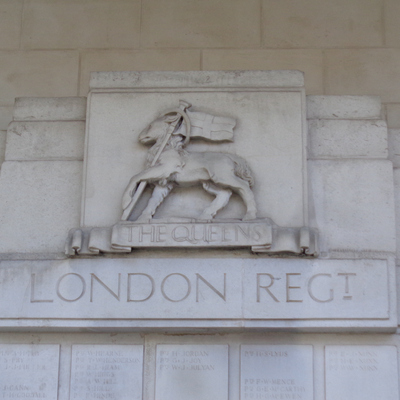Sorry, we've done no research on WW2, it's just too big a subject. But do visit the picture source web site - it has a fascinating collection of maps. And we enjoyed these photos of . Also for some signs of WW2 on buildings in London see .
February 2015: did something we’ve been meaning to do for ages: they’ve brought together all the various heads of state and governments-in-exile that found a home in London during WW2. We’ve shamelessly taken that splendid research and linked it to the associated memorials that we’ve found.
The Free French wartime headquarters were at 1 Dorset Square and at Carlton Gardens where there are two plaques and a statue. De Gaulle lived in Hampstead.
The Netherlands’ head of state, Queen Wilhelmina, lived at Claridge’s and had her Secretariat at 77 Chester Square where there is a plaque. The Dutch government initially met in the Dutch Reformed Church at 7 Austin Friars but this was destroyed by bombs in 1940 which may be what prompted them to move to Stratton House, 79 Piccadilly. And the Dutch club was at Oranjehaven.
The Polish Prime Minister Sikorski based himself in the Polish embassy at 47 Portland Place. The Polish President Raczkiewicz lived at 43 Eaton Place and ran his government in exile from here.
Belgium’s government-in-exile was based at the Belgian embassy at 105 Eaton Square.
The President of Czechoslovakia, Edvard Beneš, lived at 26 Gwendolen Avenue Putney. The Czech government in exile was run from 3-8 Porchester Gate, Bayswater Road.
King Haakon of Norway officially lived at the Norwegian embassy at 10 Palace Green W8 where there is a plaque (not at 10 Kensington Palace Gardens) but often stayed at Claridges. Prime Minister Nygaardsvold ran his government-in-exile from Kingston House North on Prince’s Gate.
King Peter II of Yugoslavia lived at Claridges. His government in exile was run from Kingston House, the same address as the Norwegian government.
Luxembourg based its government in exile at 27 Wilton Crescent.
King George II of Greece lived at Claridges.
We believe these were also based in London but we need more information: Denmark’s government; King Zog of Albania; Emperor Haile Selassie of Abyssinia.







Comments are provided by Facebook, please ensure you are signed in to see them